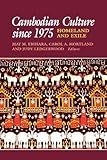Cambodian Culture since 1975 : Homeland and Exile / ed. by Carol A. Mortland, May Mayko Ebihara, Judy Ledgerwood.
Material type: TextSeries: Asia East by SouthPublisher: Ithaca, NY : Cornell University Press, [2018]Copyright date: ©1994Description: 1 online resource (216 p.) : 1 drawingContent type:
TextSeries: Asia East by SouthPublisher: Ithaca, NY : Cornell University Press, [2018]Copyright date: ©1994Description: 1 online resource (216 p.) : 1 drawingContent type: - 9781501723858
- 959.604
- DS554.8.C359 1994
- online - DeGruyter
| Item type | Current library | Call number | URL | Status | Notes | Barcode | |
|---|---|---|---|---|---|---|---|
 eBook
eBook
|
Biblioteca "Angelicum" Pont. Univ. S.Tommaso d'Aquino Nuvola online | online - DeGruyter (Browse shelf(Opens below)) | Online access | Not for loan (Accesso limitato) | Accesso per gli utenti autorizzati / Access for authorized users | (dgr)9781501723858 |
Frontmatter -- Contents -- Acknowledgments -- Preface -- Note on Transliteration: Franco-Khmer Transcription System of Franklin E. Huffman -- CHAPTER ONE. Introduction -- CHAPTER TWO. Khmer Literature since 1975 -- CHAPTER THREE. Khmer Traditional Music Today -- CHAPTER FOUR. The Revival of Masked Theater, Lkhaon Khaol, in Cambodia -- CHAPTER FIVE. Cambodian Buddhist Monasteries in Paris: Continuing Tradition and Changing Patterns -- CHAPTER SIX. Khmer Buddhists in the United States: Ultimate Questions -- CHAPTER SEVEN. Khmer Proverbs: Images and Rules -- CHAPTER EIGHT. Metaphors of the Khmer Rouge -- CHAPTER NINE. Gender Symbolism and Culture Change: Viewing the Virtuous Woman in the Khmer Story “Mea Yoeng” -- CHAPTER TEN. Sharing the Pain: Critical Values and Behaviors in Khmer Culture -- CHAPTER ELEVEN. Cultural Consumption: Cambodian Peasant Refugees and Television in the “First World” -- Notes -- References -- Notes on Contributors -- Index
restricted access online access with authorization star
http://purl.org/coar/access_right/c_16ec
Since the civil war of the 1970s, Cambodia has suffered devastating upheavals that killed a million ' people and exiled hundreds of thousands. This book is the first to examine Cambodian culture after the ravages of the Pol Pot regime-and to bear witness to the transformation and persistence of tradition among contemporary Cambodians at home and abroad. Bringing together essays by Khmer and Western scholars in anthropology, linguistics, literature, and ethnomusicology, the volume documents the survival of a culture that many had believed lost. Individual chapters explore such topics as Buddhist belief and practice among refugees in the United States, distinctive features of modern Cambodian novels, the lessons taught by Khmer proverbs, some uses of metaphor by the Khmer Rouge regime, the state of traditional music, the recent revival of a form of traditional theater, the concept of pain in Khmer culture, changing conceptions of gender, and refugees' interpretation of American television. Together the essays map a contemporary Cambodian culture, which, for over two hundred thousand Khmers, is now firmly entwined in the social fabric of the urban West.
Mode of access: Internet via World Wide Web.
In English.
Description based on online resource; title from PDF title page (publisher's Web site, viewed 26. Apr 2024)


